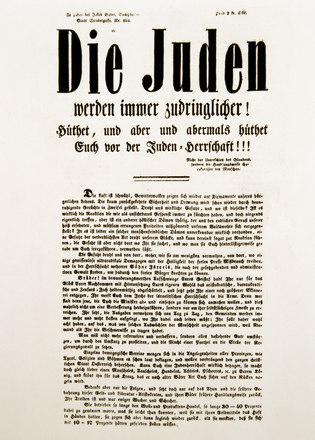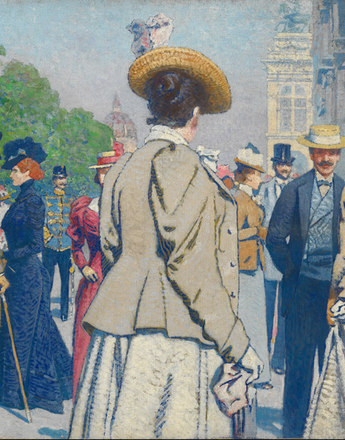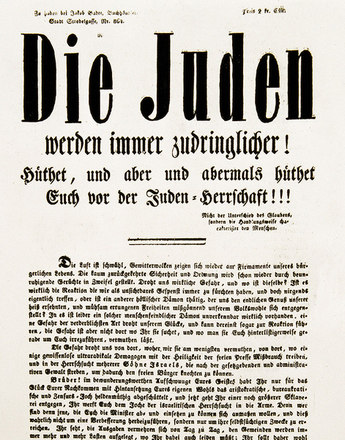Anti-liberalism – anti-capitalism – anti-Semitism
The 1873 stock exchange crash and the subsequent social tension brought a sudden end to the hopes of the Jewish population of achieving complete social equality through their own modernisation and assimilation efforts.
The "Great Depression" that followed the 1873 stock exchange crash led not only to poverty and economic stagnation but also to an accelerated economic change. Driven by rationalisation measures in production, trade, crafts and small industry underwent a gradual modernisation. The rapid industrialisation led to workers being divided into skilled workers, industrial workers and new private sector employees.
Craftsmen and small traders felt themselves threatened by these rapid changes, resulting in increased social tensions between the individual groups. In the conservative camp, the previously optimistic confidence in the capitalist structure of the economy and society was abruptly shattered. Instead, an increasingly anti-capitalist attitude became apparent that forced democratic approaches in society into the background.
The economic tension became the feeding-ground for a new anti-Semitism that saw the "Jewish question" as the cause of the economic crisis and led to the germination of anti-Jewish conspiracy theories. Social problems were blamed on the apparently easily identifiable group of Jews. In the dichotomous contrast between the Jews and the 'Christian people', the stock exchange crash was interpreted as 'Jewish treachery'. Traditionally associated with money and finances, the Jew was identified as the culprit. Anti-Semites regarded the capitalist means of production as a global Jewish conspiracy that could only be combated with anti-Jewish legislation. This social change was accompanied and encouraged by anti-Jewish publications in the conservative and Catholic press.
Conservative circles above all in the petty bourgeoisie and middle-class were the exponents of this new type of anti-Semitism. For them, anti-Semitism was a cultural code and the expression of a philosophy that comprised a whole bundle of conservative values: they were opposed to liberalism, capitalism and socialism, fought against the civil rights and liberties of the Jewish population, were tied to the Church and adopted a dynastic approach and corporative ideas. In reaction to the socio-economic changes, the feeling of being threatened by capitalism was associated with anti-Jewish agitation and Jews became the target of anti-liberal policies.
Translation: David Wright
Bunzl, John/Marin, Bernd: Antisemitismus in Österreich. Sozialhistorische und soziologische Studien, Innsbruck 1983
Kienzl, Lisa: Das goldene Zeitalter der Sicherheit. Nationale österreichische Identitätskonstruktionen und deren Beziehung zum wachsenden Antisemitismus im deutschsprachigen Raum der Donaumonarchie 1866-1914, unveröffentlichte Dissertation, Graz 2012
Maderthaner, Wolfgang/Musner, Lutz: Die Anarchie der Vorstadt. Das andere Wien um 1900, Frankfurt/New York 1999
Pulzer, Peter: Spezifische Momente und Spielarten des Österreichischen und des Wiener Antisemitismus, in: Botz, Gerhard et al. (Hrsg.): Eine zerstörte Kultur. Jüdisches Leben und Antisemitismus in Wien seit dem 19. Jahrhundert, 129-146
Vocelka, Karl: Geschichte Österreichs. Kultur – Gesellschaft – Politik, München 2002
-
Chapters
- Antisemitism: A historical definition
- Jewish life in the Habsburg Empire
- Anti-liberalism – anti-capitalism – anti-Semitism
- Antisemitism as a political movement
- "I decide who is a Jew"
- The social exponents of Austrian anti-Semitism
- Anti-Semitism in other nationalities within the Habsburg Monarchy
- The Habsburg Monarchy as the guarantee of pluralistic identities
- Jewish soldiers in the Austro-Hungarian army
- The "Eastern Jews" as a pivotal point for anti-Jewish agitation
- The breakdown of the internal peace




